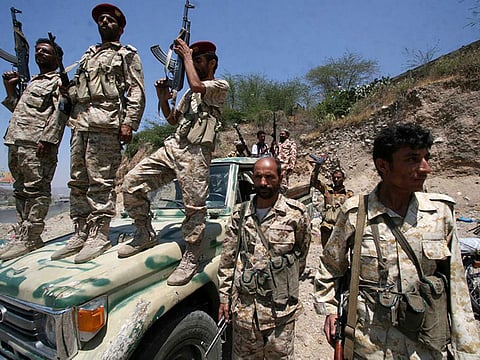New tactics lead to victories on Red Sea front
Cooperation between Yemeni factions and death of senior Al Houthis contribute to loyalists’ success

Al Mukalla: In about a week, the Iran-backed Al Houthis have lost control of two districts, a military base and large swathes of lands in the Taiz province, in addition to a strategic seaport in Al Tuhayata district in the province of Hodeida.
Military experts attributed the rapid military gains made by the UAE-backed Yemeni forces west of Taiz and along the country’s western coastline in Hodeida to better battlefield tactics, cooperation between different military factions, and the death of senior Al Houthi political and military commanders.
More than a week ago, hundreds of troops from the National Resistance led by General Tarek Mohammad Abdullah Saleh, the Giant Brigades and Tehami Resistance launched a joint military offensive on Al Houthi-held areas west of Taiz city.
Despite the rough topography of the area and thousands of landmines planted by Al Houthis, the troops advanced quickly into the battlefield, seizing control of Mawza and Al Wazyia districts, and stormed the Al Ameri military camp.
Al Houthis are facing serious forces that seek to achieve victory and restore the state [authority].”
After the current victories, government forces encircled Al Houthis, who had laid siege to Taiz, Yemen’s third-largest city.
“Al Houthis are facing serious forces that seek to achieve victory and restore the state [authority],” Brigadier Jamal Al Ma’mari, a military analyst, told Sky News Arabia, referring to thousands of elite forces that defected from Al Houthis after the killing of Ali Abdullah Saleh, Yemen’s ousted president, in December.
In addition to easing pressure on government forces in Taiz, the aim of the current offensive on the west of Taiz is to prevent Al Houthis in the rugged mountains from attacking government forces advancing towards the city of Hodeida.
General Tarek’s men are from the elite Republican Guards and Special Forces that shored up Al Houthis during their military expansion in late 2014 and early 2015, and helped Al Houthis fight off aggressive military assaults by government troops and the Saudi-led coalition.
Al Ma’mari said the decision to expel Al Houthis from Taiz before marching towards Hodeida was a smart one that led to the cutting off of military supplies to Al Houthis and hence led to the collapse of their forces on the Red Sea battlefield.
“Marching along the [Red Sea] coastline left forces vulnerable to Al Houthi attacks. This mistake was fixed,” Al Ma’mari said.
Other military analysts link Al Houthis’ major battlefield setbacks to the death of their military and political leaders in Saudi-led air strikes.
Ali Al Khilaki, a Yemeni military analyst based in the southern city of Aden, said the death of Saleh Al Sammad, the president of Al Houthi Supreme Political Council, who was killed in an air strike last month, was a big blow to Al Houthis.
“The death of Al Samad was a devastating blow that caused chaos in their ranks,” Al Khilaki said, adding that Al Houthis would respond to defeats by increasing their ballistic missile attacks on Saudi Arabia to shore up the morale of their militiamen and to pretend they have the upper hand on the battlefield.
“They would also put up pressure on tribes to send their children to the battlefield,” Al Khilaki said.
Since the beginning of 2018, Yemen’s army and the Saudi-led coalition have opened new fronts inside Saada, Al Houthis’ main bastion that hosts their major arsenal of ballistic missiles and key leaders. The pressure in Saada has prevented Al Houthis from sending reinforcements to other fronts, including the Red Sea which helped government forces to advance there, analysts said.
“All battlefields, including those in Nehim, Bouqa and Qanea, must flare up now. This will significantly lead to the fall of the enemy,” Al Ma’mari said.
Sign up for the Daily Briefing
Get the latest news and updates straight to your inbox



